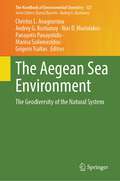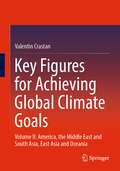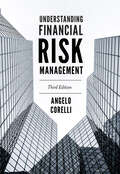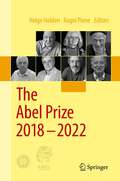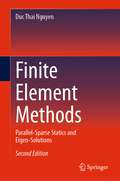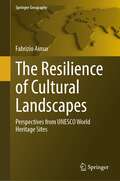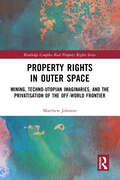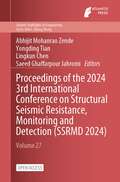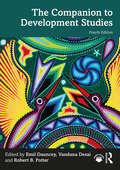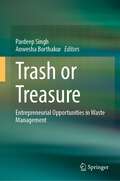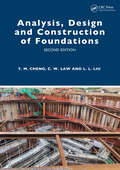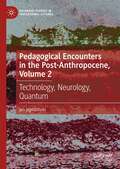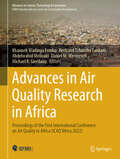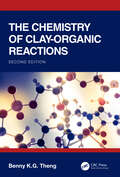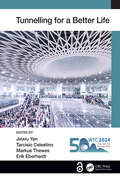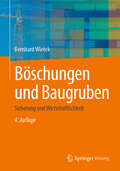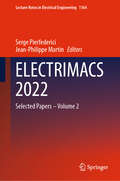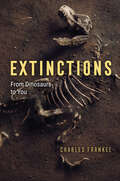- Table View
- List View
The Aegean Sea Environment: The Geodiversity of the Natural System (The Handbook of Environmental Chemistry #127)
by Andrey G. Kostianoy Christos L. Anagnostou Ilias D. Mariolakos Panayotis Panayotidis Marina Soilemezidou Grigoris TsaltasThis is the first of three Books that together provide an integrated picture of the Aegean Sea, presenting the natural components of the system (Book I and Book II) as well as the human presence in the extended area (Book III). The Aegean Sea, also called Aegean Archipelagos, is an open, complex, and diverse marine system situated between the Black Sea and the Eastern Mediterranean, with different compartments and interactions. This book provides an in-depth exploration of the Aegean Sea's natural systems, shedding light on its geodiversity, geological dynamics, air-land-sea interaction, hydrology, suspended matter and sediments. Divided into 4 parts, the book introduces the diversity, geological dynamics, and evolution of the natural system of the Aegean Sea (Parts 1 and 2), followed by a section devoted to the land-sea interaction in the Aegean coastal system where experts in the field explore freshwater and matter inputs into the Aegean coastal system, as well as the coastal morphodynamics and evolution of the Aegean Sea, its adjacent land areas, and islands. In Part 3, the book delves into the air-sea interaction over the Aegean Sea, presenting its intricate dynamics, including heat and freshwater fluxes, wind waves, tides, and atmospheric deposition. The book closes with a section focused on the hydrology, chemistry, and dynamics of water masses and the sea bottom, providing insights into suspended matter and fluxes, sediments, climate changes, and the intricate nutrient and carbon dynamics within the Aegean Sea ecosystem (Part 4). Given the breadth and depth of its coverage, this book serves as a valuable resource for researchers, scholars, and students interested in marine geology, oceanography, and environmental analysis, as well as policymakers and conservationists seeking a comprehensive understanding of the Aegean Sea's complex natural systems.
Key Figures for Achieving Global Climate Goals: Volume II: America, the Middle East and South Asia, East Asia and Oceania
by Valentin CrastanThis volume analyses the energy industry for the following geographical units: America – divided into North America (Canada + USA) and Central and South America –, the Middle East and South Asia, East Asia and Oceania. The key energy-economic indicators for each region and country and their development, are illustrated in numerous graphs and energy flow diagrams. Based on this analysis, the author recommends a distribution of emission reductions necessary to limit climate change (for the 2°C and 1.5°C climate goals, with a perspective up to 2050).The continents covered in this volume collectively account for 77% of emissions. Europe + Eurasia and Africa will be addressed in volume I.
Understanding Financial Risk Management
by Angelo CorelliFinancial risk management is a topic of primary importance in financial markets. It is important to learn how to measure and control risk, how to be primed for the opportunity of compensative return, and how to avoid useless exposure. This third edition of Understanding Financial Risk Management offers an updated version of its innovative approach to such issues. Angelo Corelli analyses the various types of financial risk that a financial institution now face in everyday operations—including market, interest rate, credit, liquidity, operational, currency, volatility, and enterprise risk. He deals with each type of risk using a rigorous mix of analytical and theoretical approaches; he gives introductory overviews to the most relevant statistical and mathematical tools; and he provides innovative analyses of all the major models available in the literature. This broad view of theory and the current state of the industry provides a friendly but serious starting point for those who encounter risk management for the first time, and it offers plenty of food for thought to more advanced readers. For its unique mix of rigour and accessibility, this book is a must-read for finance professionals, and it is of keen interest to finance students and researchers.
Understanding Financial Risk Management
by Angelo CorelliFinancial risk management is a topic of primary importance in financial markets. It is important to learn how to measure and control risk, how to be primed for the opportunity of compensative return, and how to avoid useless exposure. This third edition of Understanding Financial Risk Management offers an updated version of its innovative approach to such issues. Angelo Corelli analyses the various types of financial risk that a financial institution now face in everyday operations—including market, interest rate, credit, liquidity, operational, currency, volatility, and enterprise risk. He deals with each type of risk using a rigorous mix of analytical and theoretical approaches; he gives introductory overviews to the most relevant statistical and mathematical tools; and he provides innovative analyses of all the major models available in the literature. This broad view of theory and the current state of the industry provides a friendly but serious starting point for those who encounter risk management for the first time, and it offers plenty of food for thought to more advanced readers. For its unique mix of rigour and accessibility, this book is a must-read for finance professionals, and it is of keen interest to finance students and researchers.
The Abel Prize 2018-2022 (The Abel Prize)
The book presents the winners of the Abel Prize in mathematics for the period 2018–2022: - Robert P. Langlands (2018) - Karen K. Uhlenbeck (2019) - Hillel Furstenberg and Gregory Margulis (2020) - Lászlo Lóvász and Avi Wigderson (2021) - Dennis P. Sullivan (2022) The profiles feature autobiographical information as well as a scholarly description of each mathematician’s work. In addition, each profile contains a Curriculum Vitae, a complete bibliography, and the full citation from the prize committee. The book also includes photos from the period 2018–2022 showing many of the additional activities connected with the Abel Prize. This book follows on The Abel Prize: 2003–2007. The First Five Years (Springer, 2010) and The Abel Prize 2008–2012 (Springer, 2014) as well as on The Abel Prize 2013–2017 (Springer, 2019), which profile the previous Abel Prize laureates.
Finite Element Methods: Parallel-Sparse Statics and Eigen-Solutions
by Duc Thai NguyenThis new edition includes three new chapters, 7 through 9, that have very broad, practical applications in engineering and science. In addition, the author’s latest research results incorporated into the new textbook demonstrates better performance than the popular METIS software for partitioning graphs, partitioning finite element meshes, and producing fill-reducing orderings for sparse matrices. The new Chapter 8, and its pre-requisite, Chapter 7, present a state-of-the-art algorithm for computing the shortest paths for real-life (large-scale) transportation networks with minimum computational time. This approach has not yet appeared in any existing textbooks and it could open the doors for other transportation engineering applications. Chapter 9 vastly expands the scope of the previous edition by including sensitivity (gradient) computation and MATLAB’s built-in function “fmincon” for obtaining the optimum (or best) solution for general engineering problems.
The Resilience of Cultural Landscapes: Perspectives from UNESCO World Heritage Sites (Springer Geography)
by Fabrizio AimarThis book explores the possibility of building the resilience of the UNESCO cultural landscapes, both using theoretical conceptions and practical strategies and actions. Two case studies have been selected, one in Italy and one in China, which have then been explored for the first time in such a comparative way. Different notions of landscape, as well as the driving force of changes affecting these landscapes, are examined and compared. Moreover, the perceptions of the local communities regarding these landscapes are examined, using online questionnaires with over 400 participants. This research highlights the need for an integrated management system, building stronger rural communities able to manage change and continuity. Five pillars to build the resilience of these landscapes have been provided, with schemes and figures, requiring a people-centered approach in their management. This book demonstrates strong connections between identity and landscape resilience, especially in inlandareas where the sense of identity is most prominent. Furthermore, it is structured to make it possible to replicate this investigation in ordinary case studies, i.e. ordinary landscapes. Scholars and professionals interested in cultural landscapes and heritage conservation are target of this book, as well as site managers.
Property Rights in Outer Space: Mining, Techno-Utopian Imaginaries, and the Privatisation of the Off-World Frontier (Routledge Complex Real Property Rights Series)
by Matthew JohnsonThis book explores the role of private mining rights in the utopian imaginary of space colonisation. It presents a transdisciplinary account of the new and evolving legislative frameworks that have been established in anticipation of commercial exploitation of the mineral resources of the off-world frontier. Written in an engaging style, the book investigates a novel case study in the history of capitalism and 'the commons': the emergence of a nascent space mining industry, undergirded by a contentious legislative framework. In 2015, the US passed laws that would recognise the claims of US corporations to own and sell space resources. This unilateral act of pre-emptive law-making would appear to contravene the terms of the UN Outer Space Treaty (1967), which declared that the exploration and use of outer space should be ‘for the benefit of all mankind’ and ‘not subject to national appropriation’.Using this central dynamic between privately held mining rights and outer space as a 'global commons', Matthew Johnson constructs an historical sociology of space mining – from the deep historical roots of common and private property to the contemporary networks of neoliberalism that have engaged with the commercialisation of space activity. The anticipatory expansion of private property claims beyond the Earth both resonates with and problematises the ‘terrain’ of political history, such as the tensions between states and markets, public law and private power, ‘the commons’ and exclusive property. The emerging cosmopolitics of off-world private property mirrors (and is often explicitly embedded within) neoliberal geopolitics, prompting urgent questions about how we can reaffirm principles of democracy and ‘common heritage’ in the international laws of Earth and space. This book is compelling reading for anyone interested in the social study of space, law, economics, technology, politics and property rights.
Property Rights in Outer Space: Mining, Techno-Utopian Imaginaries, and the Privatisation of the Off-World Frontier (Routledge Complex Real Property Rights Series)
by Matthew JohnsonThis book explores the role of private mining rights in the utopian imaginary of space colonisation. It presents a transdisciplinary account of the new and evolving legislative frameworks that have been established in anticipation of commercial exploitation of the mineral resources of the off-world frontier. Written in an engaging style, the book investigates a novel case study in the history of capitalism and 'the commons': the emergence of a nascent space mining industry, undergirded by a contentious legislative framework. In 2015, the US passed laws that would recognise the claims of US corporations to own and sell space resources. This unilateral act of pre-emptive law-making would appear to contravene the terms of the UN Outer Space Treaty (1967), which declared that the exploration and use of outer space should be ‘for the benefit of all mankind’ and ‘not subject to national appropriation’.Using this central dynamic between privately held mining rights and outer space as a 'global commons', Matthew Johnson constructs an historical sociology of space mining – from the deep historical roots of common and private property to the contemporary networks of neoliberalism that have engaged with the commercialisation of space activity. The anticipatory expansion of private property claims beyond the Earth both resonates with and problematises the ‘terrain’ of political history, such as the tensions between states and markets, public law and private power, ‘the commons’ and exclusive property. The emerging cosmopolitics of off-world private property mirrors (and is often explicitly embedded within) neoliberal geopolitics, prompting urgent questions about how we can reaffirm principles of democracy and ‘common heritage’ in the international laws of Earth and space. This book is compelling reading for anyone interested in the social study of space, law, economics, technology, politics and property rights.
Proceedings of the 2024 3rd International Conference on Structural Seismic Resistance, Monitoring and Detection (Atlantis Highlights in Engineering #27)
This is an open access book. With the deepening of urbanization, there are more and more buildings in the city. The buildings are also gradually diversifying and becoming more complex. However, while the aesthetics of the building are improved, the safety of the building also needs to be fully guaranteed. Whether it is the influence of natural disasters or human factors, it may lead to damage to building structures. Therefore, the structure in civil buildings is earthquake-resistant, and the problems of disaster prevention and mitigation are emerging in an endless stream, and they need to be solved urgently. In order to solve the above problems, more and more experts and scholars have conducted in-depth research in this field, and various seismic resistance in the field of civil engineering and construction, new theories of monitoring and testing, new technologies, and new products have emerged, and academic exchanges in this field have become increasingly active. 2024 3rd International Conference on Structural Seismic Resistance, Monitoring and Detection(SSRMD 2024) will be held in Harbin on January 19-21, 2024. The conference aims to provide a platform for experts and scholars in the fields of civil architecture, structural earthquake resistance and related monitoring and testing technology to communicate and learn. The conference sincerely invites experts and scholars from universities and scientific research institutions at home and abroad, business people and other relevant personnel to participate in the conference and exchange. Scholars at home and abroad are welcome to submit articles and participate in the conference.
Innovation, Quality and Sustainability for a Resilient Circular Economy: The Role of Commodity Science, Volume 2 (Circular Economy and Sustainability)
by Carlo Ingrao Giovanni Lagioia Annarita Paiano Vera Amicarelli Teodoro GallucciThis book is the second volume of a selection of the best papers presented at the XXX National Conference of Commodity Science held in Bari, Italy on 27–28th October, 2022. It is designed to help advance the knowledge and application of Commodity Science in innovation, quality, and sustainability principles and goals. Furthermore, it provides support in confronting the current environmental and socioeconomic challenges and contributes to addressing and solving those concerns in a circular economy context. Under this perspective, the book highlights the central role that Commodity Science can play, also considering the multiple possibilities of interacting with other relevant research sectors, like food production and packaging, engineering, environmental science, organization, management, decision science, and social science, so enabling valorization and maximization. These interactions will appeal to academics, producers, decision- and policymakers, and other stakeholders. Thus, this book has a multidisciplinary holistically integrated approach to Commodity Science that contributes to enhancing the current literature and knowledge.
The Companion to Development Studies
by Vandana Desai Robert B. Potter Emil DaunceyThe Companion to Development Studies is essential reading in the field of development studies. This indispensable resource offers succinct, up-to-date, and insightful chapters that reflect the diverse voices and perspectives informing the field and the dynamic interplay of theory, policy, and practice that characterises it.This fourth edition brings together contributions from an impressive range of renowned international experts and emerging voices at the forefront of development studies to deliver engaging, interdisciplinary, and provocative insights into this challenging field. The 98 chapters spanning both theory and practice offer readers accessible discussions of the core issues, emerging trends, and key debates of the discipline. Divided into nine sections of: theories and their contentions; histories and discourses of development; actors and institutions; identities and practices; people and the planet; the economics of development; conflict, violence, and peace; the changing landscape of development; and approaches to policy and practice; this timely new text provides easy to use summaries of all the major issues encountered in this rapidly growing and changing field.The Companion serves students and scholars across various disciplines, including development studies, geography, politics, international relations, sociology, anthropology, and economics. It offers incisive analysis and critical insights, equipping those working in development policy and practice with the knowledge and understanding they need to navigate and address contemporary global challenges.This textbook is supported by flexible, online resources for teaching and learning such as tutorial guides, key concept videos, and a filmography.
Trash or Treasure: Entrepreneurial Opportunities in Waste Management
by Pardeep Singh Anwesha BorthakurIn this book, we have contributions from experts working on diverse aspects of waste management and waste entrepreneurship with an aim to contribute toward a holistic understanding of the existing and forthcoming waste handling challenges. Waste entrepreneurship refers to the practice of creating and operating businesses that aim to address the problem of waste management. It signifies businesses that are dedicated to finding innovative solutions for managing waste and plays a crucial role in building a sustainable future. Waste entrepreneurs identify waste as a valuable resource and use state-of-the-art tactics to reduce, reuse, recycle, and re-purpose it. By developing new technologies, services, and products that help reduce waste and recycle materials, they can create new economic opportunities while simultaneously reducing the environmental impact of waste. The primary audience of this book are researchers (from a wide range of disciplinary backgrounds) working in the field of waste management (especially E-waste, Plastics, Paper and Cardboard Waste, Organic Waste, and Construction and Demolition Waste) and environmental sustainability. This book also contains descriptions of various facets of waste entrepreneurship from different countries which will be helpful for different entrepreneurs looking for business opportunities in the waste management sector, NGOs, government agencies, international agencies, and new researchers working in the related fields. In particular, the book could provide start-up ideas to the enthusiastic readers.
The Companion to Development Studies
by Vandana Desai Robert B. Potter Emil DaunceyThe Companion to Development Studies is essential reading in the field of development studies. This indispensable resource offers succinct, up-to-date, and insightful chapters that reflect the diverse voices and perspectives informing the field and the dynamic interplay of theory, policy, and practice that characterises it.This fourth edition brings together contributions from an impressive range of renowned international experts and emerging voices at the forefront of development studies to deliver engaging, interdisciplinary, and provocative insights into this challenging field. The 98 chapters spanning both theory and practice offer readers accessible discussions of the core issues, emerging trends, and key debates of the discipline. Divided into nine sections of: theories and their contentions; histories and discourses of development; actors and institutions; identities and practices; people and the planet; the economics of development; conflict, violence, and peace; the changing landscape of development; and approaches to policy and practice; this timely new text provides easy to use summaries of all the major issues encountered in this rapidly growing and changing field.The Companion serves students and scholars across various disciplines, including development studies, geography, politics, international relations, sociology, anthropology, and economics. It offers incisive analysis and critical insights, equipping those working in development policy and practice with the knowledge and understanding they need to navigate and address contemporary global challenges.This textbook is supported by flexible, online resources for teaching and learning such as tutorial guides, key concept videos, and a filmography.
Analysis, Design and Construction of Foundations
by Chi Wai Law Leilei Liu Yung Ming ChengAnalysis, Design and Construction of Foundations covers the key concepts in the analysis and design of foundation systems, balancing theory with engineering practice.The book examines in depth the methods used for the analysis, design and construction of shallow foundations, deep foundations, excavation and lateral support systems, slope stability and stabilization and ground monitoring for proper site management. Some new and innovative foundation construction methods are also introduced. It is illustrated with case studies of failures and defects from actual construction projects.This second edition is extensively revised and developed to include a new chapter on numerical methods in geotechnical engineering, as well as a large number of new construction drawings, project photos and construction method statements from existing projects to give the book a stronger professional application and connection to engineering practice. It also covers some new advanced theoretical concepts not covered in other texts, making it useful in both the theoretical and practical aspects. It is ideal for senior undergraduates and graduate students, academics and consulting geotechnical engineers.
Analysis, Design and Construction of Foundations
by Chi Wai Law Leilei Liu Yung Ming ChengAnalysis, Design and Construction of Foundations covers the key concepts in the analysis and design of foundation systems, balancing theory with engineering practice.The book examines in depth the methods used for the analysis, design and construction of shallow foundations, deep foundations, excavation and lateral support systems, slope stability and stabilization and ground monitoring for proper site management. Some new and innovative foundation construction methods are also introduced. It is illustrated with case studies of failures and defects from actual construction projects.This second edition is extensively revised and developed to include a new chapter on numerical methods in geotechnical engineering, as well as a large number of new construction drawings, project photos and construction method statements from existing projects to give the book a stronger professional application and connection to engineering practice. It also covers some new advanced theoretical concepts not covered in other texts, making it useful in both the theoretical and practical aspects. It is ideal for senior undergraduates and graduate students, academics and consulting geotechnical engineers.
Pedagogical Encounters in the Post-Anthropocene, Volume 2: Technology, Neurology, Quantum (Palgrave Studies in Educational Futures)
by jan jagodzinskiAs a follow up to Pedagogical Encounters in the Post-Anthropocene, Volume I, this book addresses three major areas in response to the post-Anthropocene: Technology, Neurology, Quantum. Each of these areas is broadly addressed in relation to the concerns that have arisen both theoretically and educationally. As in Volume I, the author terms these to be encounters as each area presents a particular problematic when addressing the phase change that the planet is undergoing where the anthropogenic labour of global humanity is contributing to climate change, endangering our very existence. Technology in education has been a significant development. There is a concerted effort to review this development placing stress on the rise of learning machines and algorithms. In the second encounter the vast literature on neurology is addressed, especially neurodiversity and the various symptoms that have emerged in the post-Anthropocene era. The last section reviews issues related to quantum theory as this is fundamental to tensions between physics and metaphysics. The volume concludes with the author’s own pedagogical proposal for the future.
Advances in Air Quality Research in Africa: Proceedings of the First International Conference on Air Quality in Africa (ICAQ'Africa 2022) (Advances in Science, Technology & Innovation)
by Abdelwahid Mellouki Khanneh Wadinga Fomba Bertrand Tchanche Fankam Daniel M. Westervelt Michael R. GiordanoThis book presents the recent findings on air quality in Africa from the virtual event of the first International Conference on Air Quality in Africa (ICAQ 2022), providing a comprehensive overview on many subjects of air pollution that affect African society. It highlights research progress in the chemical and physical characterization of air pollutants, their related respiratory and non-respiratory health effects, measurements and monitoring of air pollutants using satellite remote sensing and modeling techniques, currently implemented abatement policies in different African countries, existing research and networking infrastructures, and novel tools for monitoring air quality. The advances in the development of local cost-effective air quality monitoring tools in Africa as well as the use of low-cost sensors in quantifying air quality levels are presented. This book is an enrichment for researchers, experts, and advocates of air quality, atmospheric chemistry and physics, satellite remote sensing applications, and policymakers in Africa.
The Chemistry of Clay-Organic Reactions
by Benny K.G ThengThe second edition of The Chemistry of Clay-Organic Reactions book provides a comprehensive and fully updated summary of the literature on the interactions of clay minerals with organic molecules, including reaction mechanisms and bonding modes together with their practical and industrial applications. The reader will gain an insight into the formation and properties of complexes between clay minerals and a variety of organic compounds and the use of such complexes as sorbents and carriers of organic pollutants, pesticides, dyes, and pharmaceuticals.KEY FEATURES An authoritative resource providing a detailed synthesis of published data on clay-organic complexes and reactions. Authored by a globally recognized expert in the field. Describes developments in the interactions of organic compounds with fibrous and short-range order clay minerals. This book is written for environmental and industrial chemists, organic geochemists, and soil scientists, and it will appeal to academics, researchers, industry professionals, and graduate students.
The Chemistry of Clay-Organic Reactions
by Benny K.G ThengThe second edition of The Chemistry of Clay-Organic Reactions book provides a comprehensive and fully updated summary of the literature on the interactions of clay minerals with organic molecules, including reaction mechanisms and bonding modes together with their practical and industrial applications. The reader will gain an insight into the formation and properties of complexes between clay minerals and a variety of organic compounds and the use of such complexes as sorbents and carriers of organic pollutants, pesticides, dyes, and pharmaceuticals.KEY FEATURES An authoritative resource providing a detailed synthesis of published data on clay-organic complexes and reactions. Authored by a globally recognized expert in the field. Describes developments in the interactions of organic compounds with fibrous and short-range order clay minerals. This book is written for environmental and industrial chemists, organic geochemists, and soil scientists, and it will appeal to academics, researchers, industry professionals, and graduate students.
Tunnelling for a Better Life
by Jinxiu YanTunnelling for a Better Life contain the contributions presented at the ITA-AITES World Tunnel Congress 2024, which was held from 19-25 April 2024 in Shenzhen, China. As urbanization accelerates, the pivotal role of tunnels and underground spaces in fostering environmental sustainability and improving quality of life becomes ever more pronounced. These underground structures serve as sustainable solutions to the challenges posed by rapid urban growth. By seamlessly integrating into urban landscapes, they alleviate congestion, reduce pollution, and enhance overall mobility, thus contributing to a greener and more sustainable urban environment. Moreover, tunnels and underground works provide vital support for various urban functions, such as accommodating economic activities, providing safe shelters during emergencies or disasters, and facilitating efficient utility management. They address immediate urban needs and lay the foundation for a better and more resilient future.By focusing on the latest trends in tunnelling and underground engineering, and looking ahead to the era of low-carbon and intelligent technology, the papers in this book illustrate the transformative potential of tunnels and underground works in shaping a better life for present and future generations. The contributions cover a comprehensive range of topics on tunnel engineering, showcasing the latest advancements, insights, and innovations across the following areas:1. Planning and General Aspects2. Design and Methodology3. Geotechnics, Geology and Geophysical Prospecting4. Ground Stability and Consolidation5. Support and Lining6. Conventional Tunnelling7. Mechanized Tunneling (TBM, shield)8. Immersed Tunnels9. Waterproofing and Drainage10. Instrumentation and Monitoring/ Testing and Inspection11. Digital and Information Technology12. Machine Learning13. Underground Caverns/Underground Space Use14. Operational Safety, Maintenance and Repair15. Contractual Practices and Risk ManagementTunnelling for a Better Life is a must-read for professionals, engineers, owners, and other stakeholders worldwide in tunnelling and underground engineering.
Tunnelling for a Better Life
Tunnelling for a Better Life contain the contributions presented at the ITA-AITES World Tunnel Congress 2024, which was held from 19-25 April 2024 in Shenzhen, China. As urbanization accelerates, the pivotal role of tunnels and underground spaces in fostering environmental sustainability and improving quality of life becomes ever more pronounced. These underground structures serve as sustainable solutions to the challenges posed by rapid urban growth. By seamlessly integrating into urban landscapes, they alleviate congestion, reduce pollution, and enhance overall mobility, thus contributing to a greener and more sustainable urban environment. Moreover, tunnels and underground works provide vital support for various urban functions, such as accommodating economic activities, providing safe shelters during emergencies or disasters, and facilitating efficient utility management. They address immediate urban needs and lay the foundation for a better and more resilient future.By focusing on the latest trends in tunnelling and underground engineering, and looking ahead to the era of low-carbon and intelligent technology, the papers in this book illustrate the transformative potential of tunnels and underground works in shaping a better life for present and future generations. The contributions cover a comprehensive range of topics on tunnel engineering, showcasing the latest advancements, insights, and innovations across the following areas:1. Planning and General Aspects2. Design and Methodology3. Geotechnics, Geology and Geophysical Prospecting4. Ground Stability and Consolidation5. Support and Lining6. Conventional Tunnelling7. Mechanized Tunneling (TBM, shield)8. Immersed Tunnels9. Waterproofing and Drainage10. Instrumentation and Monitoring/ Testing and Inspection11. Digital and Information Technology12. Machine Learning13. Underground Caverns/Underground Space Use14. Operational Safety, Maintenance and Repair15. Contractual Practices and Risk ManagementTunnelling for a Better Life is a must-read for professionals, engineers, owners, and other stakeholders worldwide in tunnelling and underground engineering.
Böschungen und Baugruben: Sicherung und Wirtschaftlichkeit
by Bernhard WietekDieses neu aufgelegte Buch geht mit technischem Wissen an die Problematik der Böschungen und Baugruben heran und gibt Hilfestellung, die Gefahren besser zu beherrschen und somit Schaden von der Bevölkerung abzuwenden. Böschungen als geneigte Erdoberflächen kommen überall vor. Sie werden vom Menschen mehr oder weniger bearbeitet und so der natürliche Zustand verändert. Damit sollte man auch die Auswirkungen dieser Veränderungen betrachten und sich eine Gewissheit über die Sicherheit der Böschungen verschaffen. Erst mit dieser Kenntnis sollten Veränderungen durchgeführt werden, um so auch deren Auswirkung auf den Menschen und die Umgebung abschätzen zu können. Baugruben werden immer tiefer und näher an Nachbarbauten gelegt und sind daher ingenieurmäßig zu bearbeiten. Es werden nicht immer Verfahren angewendet, die den Sicherheitserfordernissen entsprechen. Die wirtschaftlichen Anforderungen lassen oft riskante Verfahren in den Blickwinkel kommen. Es sollte jedoch neben den Kosten besonders die Sicherheit für alle Bauwerke im Vordergrund stehen.
ELECTRIMACS 2022: Selected Papers – Volume 2 (Lecture Notes in Electrical Engineering #1164)
by Serge Pierfederici Jean-Philippe MartinThis book collects a selection of papers presented at ELECTRIMACS, 2022 the14th international conference of the IMACS TC1 Committee, held in Nancy, France, on 17st-21rd May 2022. The conference papers deal with modelling, simulation, analysis, control, power management, design optimization, identification and diagnostics in electrical power engineering. The main application fields include electric machines and electromagnetic devices, power electronics, transportation systems, smart grids, electric and hybrid vehicles, renewable energy systems, energy storage, batteries, supercapacitors and fuel cells, and wireless power transfer. The contributions included in Volume 2 are particularly focused on methodological aspects, modelling, and applied mathematics in the field of electrical engineering.
Extinctions: From Dinosaurs to You
by Charles FrankelA compelling answer to an important question: Can past mass extinctions teach us how to avoid future planetary disaster? On its face, the story of mass extinction on Earth is one of unavoidable disaster. Asteroid smashes into planet; goodbye dinosaurs. Planetwide crises seem to be beyond our ability to affect or evade. Extinctions argues that geological history tells an instructive story, one that offers important signs for us to consider. When the asteroid struck, Charles Frankel explains, it set off a wave of cataclysms that wore away at the global ecosystem until it all fell apart. What if there had been a way to slow or even turn back these tides? Frankel believes that the answer to this question holds the key to human survival. Human history, from the massacre of Ice Age megafauna to today’s industrial climate change, has brought the planet through another series of cataclysmic events. But the history of mass extinction together with the latest climate research, Frankel maintains, shows us a way out. If we curb our destructive habits, particularly our drive to kill and consume other species, and work instead to conserve what biodiversity remains, the Earth might yet recover. Rather than await decisive disaster, Frankel argues that we must instead take action to reimagine what it means to be human. As he eloquently explains, geological history reminds us that life is not eternal; we can disappear, or we can become something new and continue our evolutionary adventure.
